Best Buy

Best Buy

| Public | |
| Traded as | |
| Industry | Retail |
| Founded | August 22, 1966 inSt. Paul, Minnesota, United States |
| Founder | Richard M. Schulze |
| Headquarters | |
| Products | Consumer electronics |
| Revenue | |
| Divisions | Best Buy Canada |
| Subsidiaries | |
| Website | |
| Footnotes / references[1] | |
Best Buy Co., Inc. is an American multinational consumer electronics retailer headquartered in Richfield, Minnesota. It was originally founded by Richard M. Schulze and James Wheeler in 1966[2] as an audio specialty store called Soundof Music. In 1983, it was re-branded under its current name with an emphasis placed on consumer electronics.
Best Buy operates internationally in Canada and Mexico, and formerly operated in China until February 2011 (when the faction was merged with Five Star).
The company also operated in Europe until 2012.[3] Its subsidiaries include Geek Squad, Magnolia Audio Video, and Pacific Sales. Best Buy also operates the Best Buy Mobile and Insignia brands in North America, plus Five Star in China.[3] Best Buy sells cellular phones from Verizon Wireless, AT&T Mobility, Sprint Corporation[4] in the United States. In Canada, carriers include Bell Mobility, Rogers Wireless, Telus Mobility, their fighter brands, and competing smaller carriers, such as SaskTel.
Best Buy was named "Company of the Year" by Forbes magazine in 2004,[5] "Specialty Retailer of the Decade" by Discount Store News in 2001,[6] ranked in the Top 10 of "America's Most Generous Corporations" by Forbes in 2005 (based on 2004 giving),[7] made Fortune magazine's list of "Most Admired Companies" in 2006.[8] and "The Most Sustainable Company in the United States" by Barron's in 2019.[9] Hubert Joly is executive chairman of Best Buy, having been succeeded as CEO by Corie Barry in June 2019.[10][11][12] According to Yahoo! Finance, Best Buy is the largest specialty retailer in the United States consumer electronics retail industry.[13] The company ranked No. 72 in the 2018 Fortune 500 list of the largest United States corporations by total revenue.[14]
| Public | |
| Traded as | |
| Industry | Retail |
| Founded | August 22, 1966 inSt. Paul, Minnesota, United States |
| Founder | Richard M. Schulze |
| Headquarters | |
| Products | Consumer electronics |
| Revenue | |
| Divisions | Best Buy Canada |
| Subsidiaries | |
| Website | |
| Footnotes / references[1] | |
History
Early history
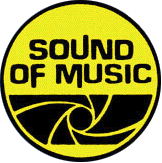
Sound of Music logo from 1966 until 1983
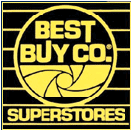
Best Buy Co. Superstores logo from 1983 until 1984
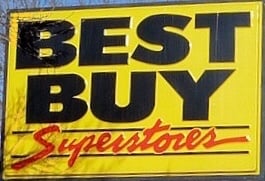
Best Buy Superstores logo from 1984 until 1989

Best Buy logo from 1989 until May 9, 2018, used in Canada until July 26, 2019
On August 22, 1966, Richard M. Schulze and a business partner opened Sound of Music, an electronics store specializing in high fidelity stereos in St. Paul, Minnesota.[15][16][17][18][19][20][21][22][23][24] Schulze financed the opening of his first store with his personal savings and a second mortgage he took out on his family's home.[23][25] In 1967, Sound of Music acquired Kencraft Hi-Fi Company and Bergo Company.[25] Sound of Music earned $1 million in revenue and made about $58,000 in profits in its first year.[23] In 1969, Sound of Music had three stores and Schulze bought out his business partner.
Sound of Music operated nine stores throughout Minnesota by 1978.[26] In 1981, the Roseville, Minnesota Sound of Music location, at the time the largest and most profitable Sound of Music store, was hit by a tornado.[23] The store's roof was sheared off and showroom destroyed, but the storeroom was left intact.[23][27] In response, Schulze decided to have a "Tornado Sale" of damaged and excess stock in the damaged store's parking lot.[23] He poured the remainder of his marketing budget into advertising the sale, promising "best buys" on everything.[27] Sound of Music made more money during the four-day sale than it did in a typical month.[24]
In 1983, with seven stores and $10 million in annual sales, Sound of Music was renamed Best Buy Company, Inc.[26][27] The company also expanded its product offerings to include home appliances and VCRs, in an attempt to expand beyond its then-core customer base of 15-to-18-year-old males. Later that year, Best Buy opened its first superstore in Burnsville, Minnesota.[27] The Burnsville location featured a high-volume, low price business model, which was borrowed partially from Schulze's successful Tornado Sale in 1981.[23][27] In its first year, the Burnsville store out-performed all other Best Buy stores combined.[24][25]
Best Buy debuted on the New York Stock Exchange in 1987.[28][29] In 1989, the company introduced a new store concept dubbed "Concept II".[25][28] Concept II replaced dimly lit industrial-style stores with brighter and more fashionably fixtured stores.[25] Stores also began placing all stock on the sales floor rather than in a stock room, had fewer salespersons and provided more self-help product information for its customers.[28][29] Best Buy also did away with commissioned salespeople.[23][28] The commission-free sales environment "created a more relaxed shopping environment free of the high-pressure sales tactics used in other stores," but was unpopular with salespersons and suppliers.[28] Some suppliers, such as Maytag, Whirlpool and Sony, were upset that salespeople would no longer be pushing their products and stopped selling in Best Buy stores altogether.[23][24] The suppliers returned after Best Buy's sales and revenue grew following the roll-out of Concept II.[27]
In 1992, the company achieved $1 billion in annual revenues.[29] In 1995, Best Buy debuted "Concept III" stores, which were larger than its previous stores.[29][30] The Concept III stores included expanded product offerings, interactive touchscreen kiosks that displayed product information for both customers and employees, and demonstration areas for products such as surround sound stereo systems and videogames.[30][31]
Best Buy launched its "Concept IV" stores with its expansion into New England in 1998.[29][32] Concept IV stores included an open layout with products organized by category, cash registers located throughout the store, and slightly smaller stores than Concept III stores.[33] The stores also had large areas for demonstrating home theater systems and computer software.[29][34]
In 1999, Best Buy was added to Standard & Poor's S&P 500.[29]
2000s
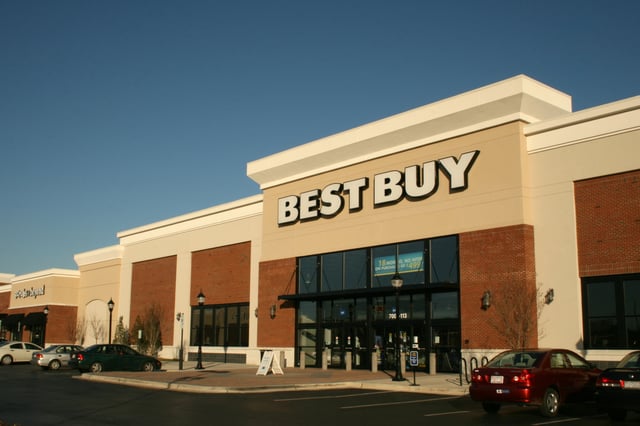
Best Buy at the Renaissance Center in Durham, North Carolina, U.S.
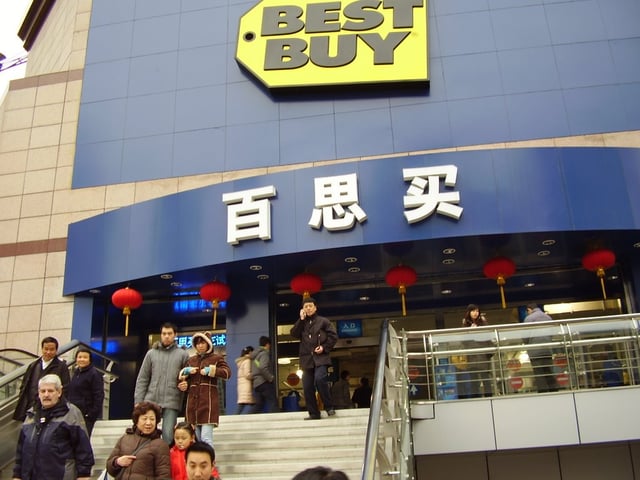
Former Best Buy Store located in Shanghai, China, now closed and merged with Five Star
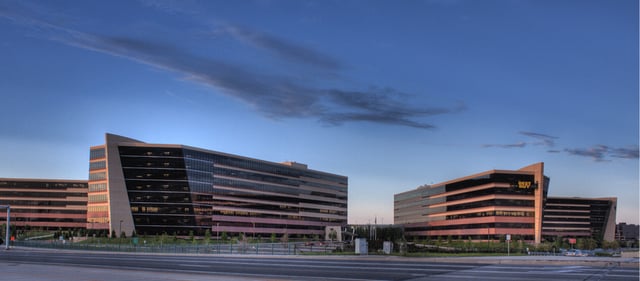
Best Buy Corporate Headquarters is located in Richfield, Minnesota, U.S., a suburb of Minneapolis

This Best Buy logo has appeared at Mall of America since 2008.
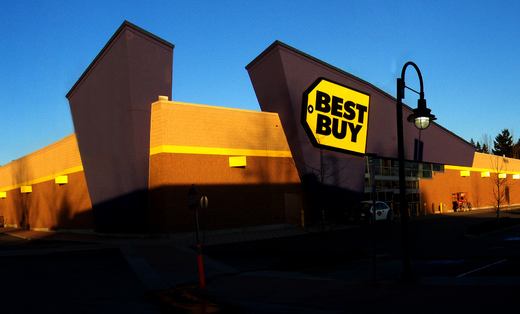
Best Buy opens its 800th store in Chicago, Illinois.
In January 2001, Best Buy acquired Musicland Stores Corporation, a Minnetonka, Minnesota-based retailer that sold home entertainment products under the Sam Goody, Suncoast Motion Picture Company, Media Play and OnCue brands. Best Buy purchased the company for $425 million in cash and the assumption of $271 million of Musicland debt.[29][36] Later that year, Best Buy acquired the British Columbia, Canada-based electronics-chain Future Shop Ltd., marking its entrance to the international marketplace.[29][37] Under the deal, Future Shop was purchased for approximately $377 million and continued to operate as subsidiary independent from Best Buy Canada.[38][39]
Brad Anderson succeeded Richard Schulze as Best Buy CEO in July 2002.[40] Anderson had begun working at Best Buy in 1973 while attending seminary school.[40] He was promoted to vice president in 1981 and executive vice president in 1986. Anderson had most recently served as president and COO of Best Buy, a position he had held since 1991.[40] In September of that year, Best Buy opened the first Canadian Best Buy-branded store in Mississauga, Ontario.[41] In October, Best Buy acquired Minneapolis-based Geek Squad, then a 24-hour residential computer repair business with offices in Minneapolis, Chicago, Los Angeles and San Francisco.[40]
Best Buy stores in the U.S. surpassed the 600-store mark and the company opened its first global-sourcing office in Shanghai in 2003.[42][43] In June, Best Buy divested itself of Musicland in a deal with Sun Capital Partners under which Sun Capital received all of Musicland's stock and debt.[44] Best Buy launched its "Reward Zone" loyalty program in July following an 8-month test of the program in San Diego, California.[45] Also in 2003, Best Buy's corporate offices were consolidated into a single campus in Richfield, Minnesota.
In January 2004, Best Buy hired Virtucom Group to revamp Best Buy's website and handle all of the company's online content.[46] In May, the company launched its "customer centricty" program, which segmented its stores according to customer profiles.
The program also called for employees to focus on specific customer groups rather than product categories.[47] In October, Best Buy completed rolling out Geek Squad "precincts" in every American Best Buy store.[48]
In April 2005, Best Buy began eliminating mail-in rebates in response to negative customer reaction against them, and instead started giving out instant rebates via notebook computers.[49]
In May 2006, Best Buy acquired a majority interest in Chinese appliance retailer Jiangsu Five Star Appliance for $180 million.
At the time of the deal, Jiangsu was the fourth-largest appliance chain in China with 193 stores across eight Chinese provinces.[50] In June, the company opened Geek Squad precincts at Office Depot in Orlando, Florida.[45] The market test was later expanded to Denver, Colorado.[51]
In January 2007, the first Best Buy-branded store in China officially opened in Shanghai, China.[52] In March 2007, Best Buy acquired Speakeasy, a Seattle, Washington-based broadband VOIP, data and IT services provider. The acquisition was worth $80 million and, under terms of the deal, Speakeasy began operating as a wholly owned subsidiary of Best Buy. The company's products also became part of Best Buy's For Business program.[53] Best Buy also expanded its Geek Squad market tests in March, opening Geek Squad precincts in FedEx Kinkos stores located in Indianapolis and Charlotte, North Carolina.[54] In October 2007, Best Buy became the first consumer-electronics retailer to exit the analog television market, carrying only digital products that became mandatory in June 2009 by the FCC.[55]
In February 2008, Best Buy opened its first store in San Juan, Puerto Rico.[56] Best Buy's Geek Squad market tests in Office Depot and FedEx Kinkos stores ended by March.[57] Also in March, the company began promoting the Blu-ray optical-disc format over the HD DVD format, a move which ultimately contributed to Toshiba's decision to drop HD DVD.[58] In May, the company agreed to buy 50% of the retail division of The Carphone Warehouse, a London, England-based mobile phone retailer.[59][60] The deal was worth $2.1 billion.[60]
In July 2008, Best Buy announced that it would start selling musical instruments and related gear in over 80 of its retail stores, making the company the second-largest musical-instrument distributor in the US.[61] Best Buy became the first third-party retail seller of Apple's iPhone in September.[62] Later that month, the company agreed to acquire Napster for $121 million.[63] In December, Best Buy opened its first store in Mexico.[64]
In February 2009, Best Buy leveraged its partnership with The Carphone Warehouse to launch Best Buy Mobile, a Best Buy-branded mobile retailer.
Best Buy Mobile standalone stores were opened in shopping malls and urban downtowns.
These Best Buy Mobile outlets were also added in all Best Buy-branded stores.[65]
In June 2009, Brian Dunn became Best Buy CEO.
Dunn replaced Brad Anderson, who was retiring.[66] Dunn had joined Best Buy in 1985 as a sales associate.
In 2000, Dunn became senior vice president of East Coast operations and president of North American retail operations in 2004.
He had most recently served as president of Best Buy, a position he had held since 2006.[67]
Best Buy partnered with Roxio's CinemaNow to launch an on-demand movie download service that would allow customers to stream content to any device sold by Best Buy that connected to the Internet in November 2009.[68] In December, the first Turkish Best Buy opened in İzmir.
2010s
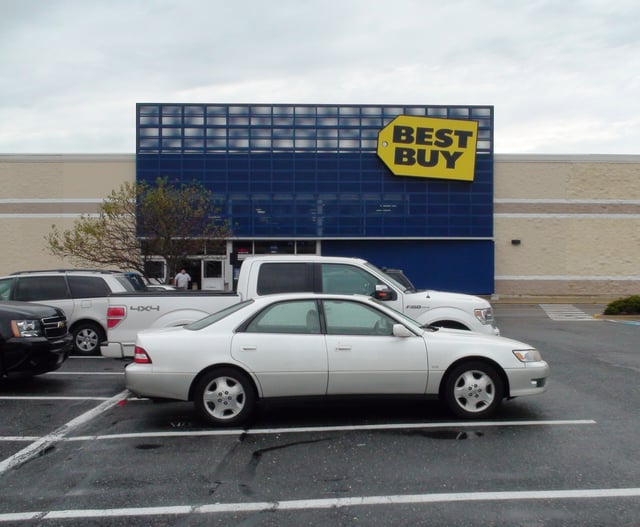
A Best Buy store in Germantown, Maryland, U.S., that opened in 2002.
In April 2010, Best Buy opened its first United Kingdom-based Best Buy-branded store in Thurrock.[69] The company eventually opened 11 Best Buy stores in the United Kingdom. The company closed all UK-based Best Buy stores in early 2012. In November 2011, Best Buy purchased The Carphone Warehouse's share of Best Buy Mobile for $1.3 billion. Best Buy and The Carphone Warehouse maintained their Best Buy Europe joint venture, which at the time operated 2,500 mobile phone stores throughout Europe.[70]
The company closed all of its Best Buy-branded stores in China by February 2011, when it merged Best Buy China's operations with Jiangsu Five Star, which had become a wholly owned subsidiary of Best Buy in 2009.[3][71] In December 2011, Best Buy purchased mindSHIFT Technologies, a company that provided IT support for small and medium-sized businesses, for $167 million.[72]
In 2012, in response to overall revenue decline, Best Buy announced plans to undergo a "transformation strategy".
Stores began to adopt a redesigned "Connected Store" format, providing the Geek Squad with a centralized service desk and implementing a "store-within-a-store" concept for Pacific Kitchen & Bath and Magnolia Design Center.[73]
In April 2012, Brian Dunn resigned as Best Buy's CEO during an internal company investigation into allegations of personal misconduct stemming from an inappropriate relationship with a female Best Buy employee.[74] Best Buy named Director George L. Mikan III interim CEO following Dunn's resignation.[74] The internal investigation was released in May 2012 and alleged that Best Buy founder and chairman Richard Schulze knew of Dunn's inappropriate relationship and failed to notify the Best Buy board.[74] Schulze subsequently resigned his chairmanship of the company.[74] Best Buy Director Hatim Tyabji replaced Schulze as Best Buy chairman.[74]
Hubert Joly replaced Mikan as Best Buy CEO in September 2012.[75] Joly had previously served as CEO of Carlson, a hospitality conglomerate, since 2008.[75] He led initiatives such as price matching, speeding up delivery times for online purchases, establishing "store within a store" sections for major brands such as Apple, Google, Microsoft and Samsung, and giving more product training to employees.[76]
An increasing trend towards online shopping began to erode revenues and profits in the 2010s.
A 4% dip in sales for the June 30, 2014 quarter, marked the tenth quarter in a row where Best Buy's sales had declined.
The company, in announcing the result, said it was focusing more on digital-media in its marketing, moving away from newspaper, magazine, and television advertising.[79]
On March 28, 2015, Best Buy announced the shutdown of the Future Shop chain in Canada; 65 of its 131 former locations were converted into Best Buy locations, while the rest (primarily those in close proximity to an existing Best Buy) were closed permanently.[80]
On March 1, 2018, the company announced that it would shut down its 250 standalone Best Buy Mobile stores in the United States by the end of May, due to low revenue and high costs.
The Best Buy Mobile stores were reported to account for 1 percent of the company's revenue.[81]
On May 9, 2018, the company unveiled a new logo for the first time in nearly three decades.[82]
On July 2, 2018, Best Buy announced it was cutting the amount of store space devoted to selling physical music, citing the popularity of streaming services as having reduced sales.[83]
Corporate affairs
Business operations
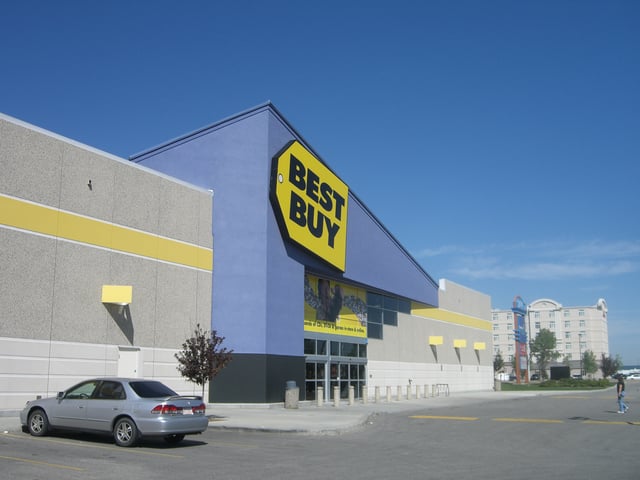
Best Buy Store in Edmonton, Alberta, Canada
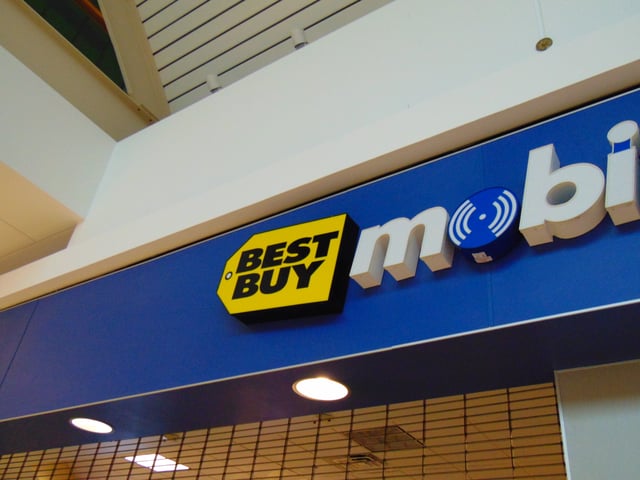
The Former Best Buy Mobile located in the Brass Mill Center, Waterbury, Connecticut, United States.
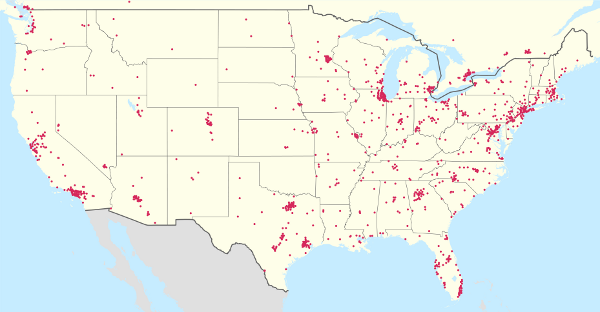
Map of Best Buy stores in the Continental U.S and Southern Canada, as of August 2011
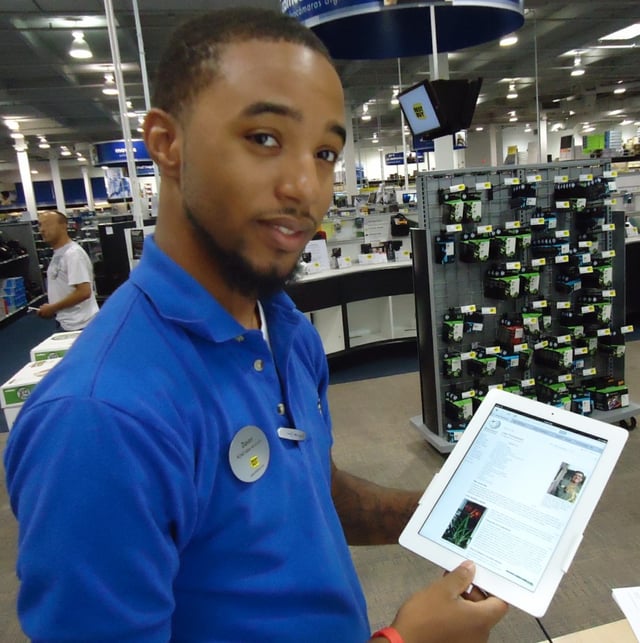
Salesman demonstrating the Apple iPad 2 (June 2011)
Best Buy sells consumer electronics and a variety of related merchandise, including software, video games, music, mobile phones, digital cameras, car stereos and video cameras, in addition to home appliances (washing machines, dryers, and refrigerators), in a non-commissioned sales environment.[3] Under the Geek Squad brand, Best Buy offers computer repair, warranty service, and accidental service plans.[3] Best Buy provides an online community forum for members, where consumers can discuss product experiences, ask questions and get answers from other members or retail product experts.[84]
The building exteriors of Best Buy-branded stores are typically light brown, with the entrance designed to look like a blue box emerging from the structure.[85] Corporate employees operated under a results only work environment from 2005 until March 2013, when the management style was abandoned by Best Buy CEO Hubert Joly.[86][87]
As of October 29, 2016, Best Buy operated 1,026 Best Buy, 331 Best Buy Mobile stand-alone stores and 28 stand-alone Pacific Sales stores in the US.[3] Best Buy also operated: 135 Best Buy and 53 Best Buy Mobile stand-alone stores in Canada; and 18 Best Buy stores and 5 Best Buy Express stores in Mexico.[3] Best Buy exited the European market in April 2013.[77][78]
House brands
Best Buy also produces products under eight house brands:[3]
Dynex – Discount electronic and computer equipment such as Blu-ray players, data and power cables, HDTVs, office supplies, storage media, and webcams
Init – Storage products such as media storage, equipment bags, totes, and furniture for home theaters
Insignia – Electronic equipment, small appliances, and accessories including adapters, cables, HDTVs, mini refrigerators, and tablets
Magnolia Design Center (in select Best Buy stores) - design and installation of custom home theater setups
Magnolia Home Theater (in select Best Buy stores) – High-end home theater selections for both audio and visual equipment, including 4K, 3D, and large televisions, projectors, receivers, and speakers
Modal – style-oriented mobile accessories, including Bluetooth speakers, cables, and cases
Pacific Sales (in select Best Buy stores) – High-end appliances
Platinum – Highest-quality in-house brand for the company, producing many products, such as cables, cell phone accessories, tablet accessories, and digital imaging equipment
RocketFish – Cables primarily used with home-theater installation and setup as well as on computer and gaming accessories
RocketFish Mobile – Phone cases, gel skins, clips, and chargers for cell phones, GPS, and other exclusive high-end products
Controversies
Warranty
In 2000, two Florida consumers brought a lawsuit against the company, alleging that it engaged in fraudulent business practices related to the sale of extended warranties (or, more accurately, service plans). The suit claimed that store employees had misrepresented the manufacturer's warranty in order to sell its own Product Service/Replacement Plan and that Best Buy had "entered into a corporate-wide scheme to institute high-pressure sales techniques involving the extended warranties" and that the company used "artificial barriers to discourage consumers who purchased the 'complete extended warranties' from making legitimate claims."[88] The company ultimately settled for $200,000 but admitted no wrongdoing.[89]
In 2014, Best Buy settled for $4.55 million in a class action lawsuit filed against them in April 2010 by consumers who claimed Best Buy was making unsolicited phone calls in contravention of the Telephone Consumer Protection Act.[90]
Pricing
In the second quarter of 2007, Connecticut Attorney General Richard Blumenthal ordered an investigation into the company's use of an in-store website alleged to have misled customers on item sales prices.[91] In December 2007, the Los Angeles Times reported on the same issue, in which some customers claimed they thought they were surfing the Internet version of bestbuy.com at an in-store kiosk only to learn that the site reflected in-store prices only. In response, company spokesperson Sue Busch indicated the in-store kiosks were not intended for price-match purposes and rather were a means to navigate in-store availability. Since the initial investigation, a banner was placed on the in-store site to make its customers more aware of the difference.[92]
Analog televisions
On April 26, 2008, the U.S. Federal Communications Commission (FCC) fined the company $280,000 for not alerting customers that the analog televisions it sold would not receive over-the-air stations after the digital transition on June 12, 2009.[93] The company challenged this ruling in May 2008 by the FCC saying it was and is in compliance with current FCC regulations pertaining to the digital transition.[94]
Environmental issues
Best Buy was one of several companies named in a 2007 report by Greenpeace for purchasing raw materials or manufactured products derived thereof from logging companies that, in the opinion of Greenpeace, contribute to unethical deforestation of taiga in Canada.[95]
Since that time, however, the company launched what it calls Greener Together to increase the energy efficiency of its products as well as reduce consumer waste through more recyclable packaging and proper disposal of certain electronic components such as rechargeable batteries, and empty ink cartridges.[96]
As a way to improve its image and past environmental issues, the company introduced a recycling program in 2009 that has since collected nearly half-a-billion pounds of consumer electronics and e-waste and is available at all their stores for a nominal fee.
These items are then handed over to certified recyclers in the U.S. for proper recycling.
The company's goal is to collect one billion pounds of recycling.[97]
It also has been named to the U.S. Environmental Protection Agency top-50 list of the largest green-power purchasers. In 2011, the company purchased nearly 119 million kilowatt-hours (kWh) of green power – electricity generated from renewable resources, such as wind, solar, geothermal, biogas, biomass and low-impact hydropower.[98]
FBI collaboration
In their attempt to combat child pornography, the FBI hired several Best Buy employees' from the Geek Squad division to covertly work for them flagging potential targets.
In one incident, a customer brought in his computer for troubleshooting.
As it turns out, this customer's computer was found to contain images of child pornography and was flagged and promptly reported to the FBI.
The customer was charged with possession of child pornography.
Fortunately for this customer and unfortunately for the FBI, a judge had no choice but to throw "out almost all the evidence" against the defendant due to "false and misleading statements" made by "an FBI agent" while trying to secure a search warrant for the customer's house.[99]